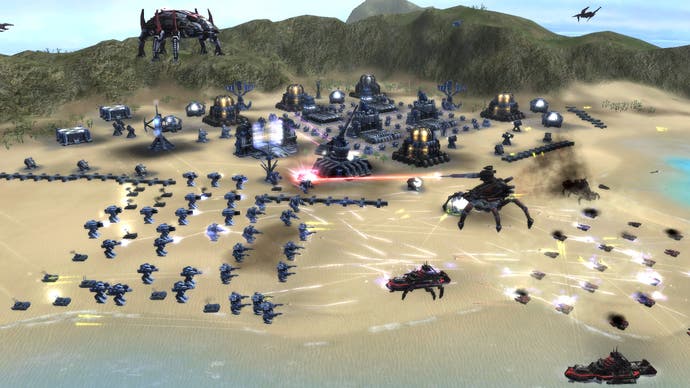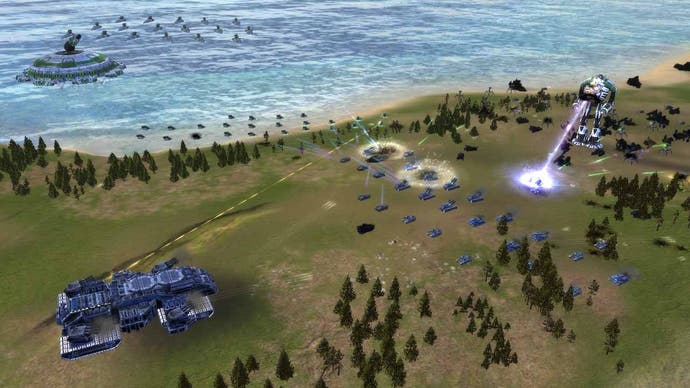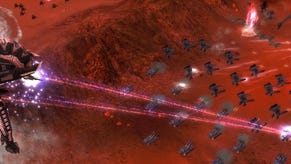Supreme Commander
Tank rushed.
Fitting Supreme Commander onto the 360 is a bit like squeezing a horse into a chest of drawers - even if you can, that doesn't mean you should. With the massive battles and sweeping strategic vision of the PC version already melting CPUs and warping motherboards on anything but high-end gaming rigs, trying to port this much sound and fury onto a console seems like an act of sheer bravery. And it undoubtedly is, but then so was the Charge of the Light Brigade. Sometimes, simple bravery is not enough. Sometimes, what's really called for is a little bit of judgement too.
The good news is that, the option to play on two monitors aside, almost all of the original game has made it across. From the choice of three factions, to the range of units, to the slow clamber up the three-level tech tree, all of the crucial elements are in place, as is the dizzy sense of scale that lies at the heart of the game. The control scheme is a success, too, although it can initially take a bit of time to get used to. Building, grouping, and issuing commands are all handled gracefully by a series of radial dials mapped to the d-pad, unit selection is taken care of by varying taps at the A button (stabs in my case, ever since I spilt chocolate milkshake on the controller), and the famous strategic zoom, which allows you to lurch from close-up action to a view of the entire battlefield in seconds, is controlled with the right thumb-stick.

The results can still be fairly intimidating - even with the on-screen stats slimmed down, there's a lot of information to take in at any one time, particularly when you've got a couple of factories chewing through some hefty build queues - but pains have clearly been taken to make Supreme Commander as simple to comprehend as a game with this kind of agenda is ever likely to be. Equally, although the lengthy tutorial possesses an almost Amish-like refusal to indulge in thrills and glamour of any kind, it provides a handy and much-needed introduction into the frightening wealth of tactical options available beyond.
And masochists will be pleased to note that, even on the lowest difficulty settings, the game is still fearsomely hard when it wants to be. From around the second mission mark, the multi-stage objectives played out across deviously designed maps will most likely see even seasoned RTS players running into trouble when fighting on more that one front. As with the PC original, the point at which the game truly clicks is when you finally comprehend the scale these particular conflicts are designed to play out at, and realise just how many units you're going to have to manufacture in order to achieve most of your goals. Supreme Commander doesn't just give you the option to think big - it demands it, and the game's focus on strategic large-scale warfare means those used to the handful of favoured pieces you'll need to keep most RTSs chugging along will be shocked by the often inhuman scale you have to think in here.

But those without a military degree from West Point will still be able to tank-rush the enemy and eventually win most encounters through sheer bloody-minded force of numbers. And that's not as bad as it sounds, as the tank rush in Supreme Commander is such a vast undertaking, requiring what can seem like hours of planning and building, that when you eventually send your units into battle for the last big push, their slow crawl across the huge map is a moment imbued with a real sense of nervous excitement. At times like this, the only way to see what's really going on is to zoom out to view the entire battlefield, and although the mass of squares, triangles, and diamond-shaped icons representing your units makes the game look like Geometry Wars for the Werthers Original crowd, it's hard not to get sucked into the mayhem as the exacting battles unfold.
It's not all good news, however, and it's the scale, ultimately, that causes most of the problems. Refusing to alter the game's design beyond installing a 500-unit cap per faction, the developer hasn't avoided compromise; it's merely shifted it elsewhere. As the game grinds on and the battlefields grow, the cracks inevitably start to show.




